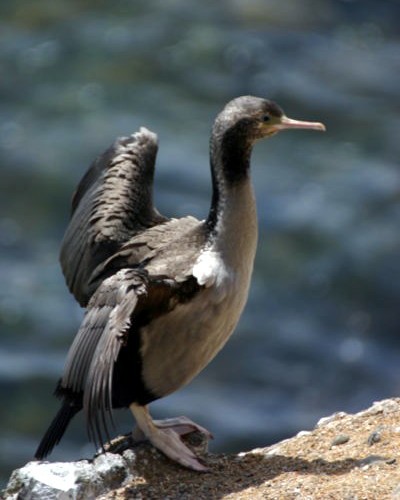Spotted Shag
A species of Typical Cormorants and Shags Scientific name : Phalacrocorax punctatus Genus : Typical Cormorants and Shags
Spotted Shag, A species of Typical Cormorants and Shags
Botanical name: Phalacrocorax punctatus
Genus: Typical Cormorants and Shags
Content
Description General Info
Description
The spotted shag is a medium-sized marine bird. They are usually between 64 and 74 centimetres (25 and 29 in) high and weigh between 700 and 1,200 grams (25 and 42 oz). Their bodies are very slim and they have a very distinctive black, decurved, double crest growing on their nape and their forehead. They have a long, slender, orange-brown coloured, hooked bill and yellow-orange feet. The feathers on their bodies are grey and blue. The adults have small black spots on their backs and wings, which gave them their name. Their irises are brown, while the ring around the iris is blue. They have a small patch of bare facial skin between their eyes and bill, which turns green-blue just before breeding season. Furthermore, non-breeding adults do not have crests and have paler underparts. The males and females do look very alike, there is almost no sexual dimorphism. Sexual dimorphism means that the males and females of a species look different and can be easily told apart, which is not the case for the spotted shag. However, the males and females can be told apart by their calls and mating behavior. Normally they do not produce much noise, only when they are at resting, roosting and nesting areas. When they produce sounds, it can be heard as loud grunts. Spotted shags usually fly in V-formation and it is hard to tell males and female apart. In flight, they look slender and pale, while their rump and tail look darker. It is hard to estimate the total number of spotted shags in New Zealand; estimates are between 10,000 and 50,000 breeding pairs (20,000 to 100,000 birds). In the past, the number of spotted shags has been limited by the availability of food, which caused an increase in number during the late 1980s. 
Size
74 cm
Nest Placement
Tree
Feeding Habits
Spotted Shag primarily consume small fish and marine invertebrates, diving from the surface to hunt underwater using their webbed feet. They may forage alone or in groups, occasionally carrying stones in their gizzard, potentially aiding digestion or parasite control.
Habitat
Spotted Shags are predominantly found in temperate coastal zones, where they thrive in marine environments such as rocky coasts, cliffs, and inshore islands. They breed on cliff faces along rocky shorelines, often forming large colonies. While they may occasionally utilize estuaries, their preferred habitats are coastal areas and offshore waters, where they forage and inhabit the surrounding marine ecosystems.
Dite type
Piscivorous
General Info
Feeding Habits
Bird food type
Distribution Area
The spotted shag is endemic to New Zealand. It breeds only on the coastlines of New Zealand and some of the offshore islands, being mainly found on the South Island. High numbers can be found on the west coast and near Stewart Island, but they also inhabit some places on the North Island. During breeding, they can mostly be found on their breeding sites, but otherwise they are more dispersed to other coastal areas. Large colonies can be found around Banks Peninsula near Christchurch, and in a rocky outcrop named the 'Shag Rock' in Wellington Harbour. Phalacrocorax punctatus are locally common, with estimates of numbers nationwide varying from 10,000 to 50,000 pairs. This species prefers to nest on cliffs along rocky coasts where they occupy ledges or cracks, forming colonies of over a thousand birds. They seldom go into freshwater environments or enclosed estuaries (Heather & Robertson, 2000). Seaweed is often used in lining the nests, the foundation of which is made of sticks. 
Species Status
The species is considered to be not threatened. 
